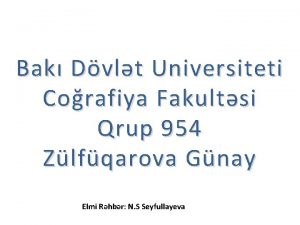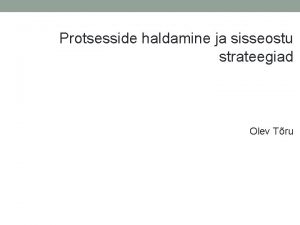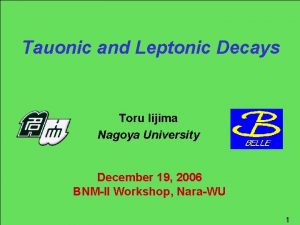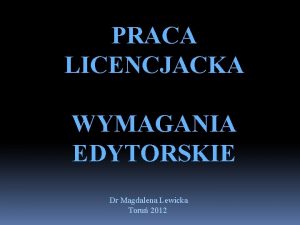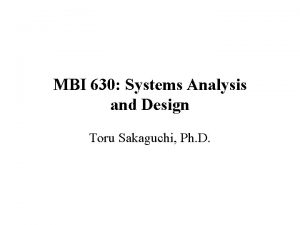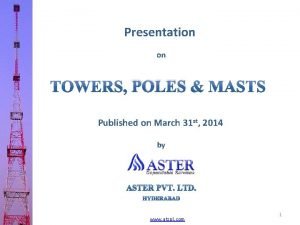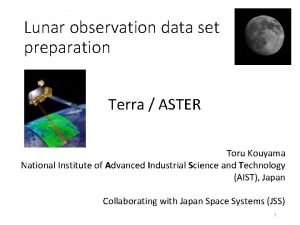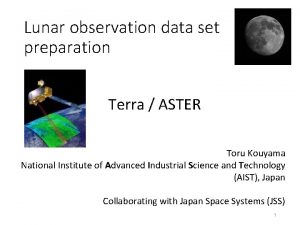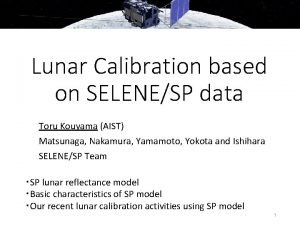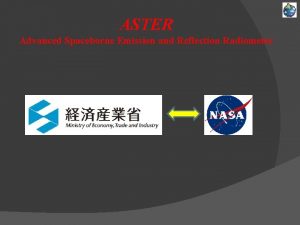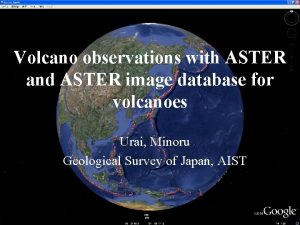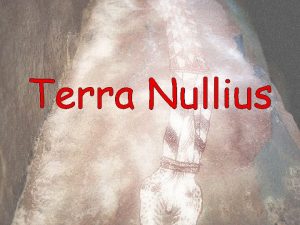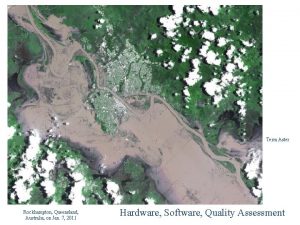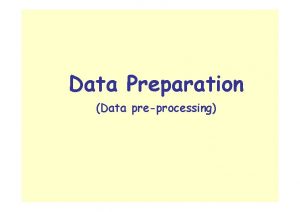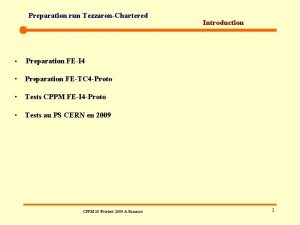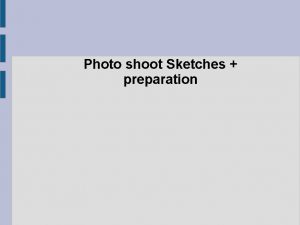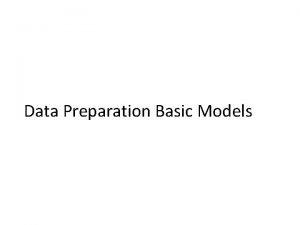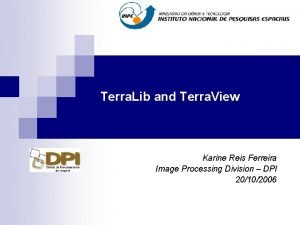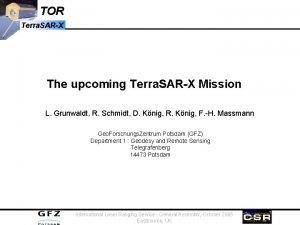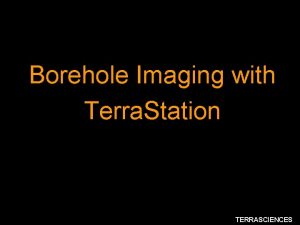Data Preparation for ASTER Terra ASTER Toru Kouyama






















![Comparison of Onboard, Vical, and Cross calibrations [Tsuchida, 2012] 23 Comparison of Onboard, Vical, and Cross calibrations [Tsuchida, 2012] 23](https://slidetodoc.com/presentation_image_h2/a141a8a3eff282db3bb93d7c7a86b2b1/image-23.jpg)
![Comparison of Onboard, Vical, and Cross calibrations [Tsuchida, 2012] 24 Comparison of Onboard, Vical, and Cross calibrations [Tsuchida, 2012] 24](https://slidetodoc.com/presentation_image_h2/a141a8a3eff282db3bb93d7c7a86b2b1/image-24.jpg)
- Slides: 24

Data Preparation for ASTER Terra / ASTER Toru Kouyama, Soushi Kato (AIST), Masakuni Kikuchi, Fumihiko Sakuma (JSS) ASTER science team/Calibration team 2 nd Lunar calibration workshop in Xi’an

Terra 1999~ General description of “Terra” and “ASTER” Operation: 1999 ~ (Current) Sensors: ASTER, MODIS, MISR, CERES, MOPITT Orbit Type Mean Altitude Orbit Period Orbit Inclination Equatorial Crossing Ground Track Repeat Polar, Sun Synchronous 705 km +/-5 km LEO 98. 8 minutes 98. 2 degrees 10: 30 AM +/- 15 minutes 16 days (233 orbits) From JSS’s brochure ASTER (Advanced Spaceborne Thermal Emission and Reflection Radiometer) operated by METI/JSS & NASA Push broom sensor composed of three instruments (VNIR, SWIR, TIR) VNIR has nadir and backward cameras for taking stereo images 2

ASTER Sensor VNIR (Visible & Near Infrared) SWIR (Short wave Infrared) TIR (Thermal Infrared) GSD (m) Swath (km) Quantiz ation (bit) 15 60 8 43. 2 30 60 8 128 60 12 Wavelength Res. Band (μm) (μrad) 1 0. 52 -0. 60 2 0. 63 -0. 69 3 N 0. 76 -0. 86 3 B 0. 76 -0. 86 4 1. 600 -1. 700 5 2. 145 -2. 185 6 2. 185 -2. 225 7 2. 235 -2. 285 8 2. 295 -2. 365 9 2. 360 -2. 430 10 8. 125 -8. 475 11 8. 475 -8. 825 12 8. 925 -9. 275 13 10. 25 -10. 95 14 10. 95 -11. 65 21. 6 18. 6 90 3

Moon Observations from ASTER/Terra Pitch maneuver Scan direction Raw image sample Oversampling factor ~ 4. 6 Image from Japan space systems Observation geometries in 2003 and 2017 (← new!) Date Phase angle Sub solar lon. Sub solar lat. Sub observer lon. Sub observer lat. Dist. Sun-Moon Dist. Moon-Terra 2003 -04 -14 -27. 7° 22. 1° -0. 9° -5. 1° -6. 8° 1. 005 AU 359, 021 km 2017 -08 -05 -20. 3° 17. 5° -0. 3° -2. 6° -4. 2° 1. 017 AU 394, 856 km SPICE/TLE

ASTER lunar images 1. How is the Moon located in the image? 2. How is the extraction performed? 3. How are the Moon pixels selected/integrated? Oversampling ratio: 4. 57 / 4. 55 Moon Diameter: Cross track: ~450 pix Along track: ~2, 100 pix Observation period: ~5 sec Along track 8200 4100 Image size: Cross track: 4, 100 pixels Along track: (Original) > 100, 000 -> 8, 200 pixels Integrating all pixels for measuring irradiance Due to the Pitch maneuver observation, Earth is out of image frame. Cross track 5

Image samples (after correcting oversampling effect) Japanese Remote Sensing journal

4. At what level of processing is the image data extracted? Product levels of ASTER L 0 B L 1 A L 1 R Raw data (non-calibrated) Calibrated Data + Calibration parameters • Dark signal level correction • Coefficients for converting count to radiance Degradation correction can be selected to be performed or not to be performed. 7

• Dark signal handling: 7. What is the deep space offset and dark signal level? How is it determined? Dark level was measured from mean deep space radiance for each line (below and above Moon position), and subtracted. Different offsets in even / odd pixels After subtraction

• Dark signal handling: 7. What is the deep space offset and dark signal level? How is it determined? Dark count (offset) was reduced, but some patterns were still remaining… Source of uncertainty? We integrated all pixels for measuring irradiance Statistically uncertainty from the patterns should be reduced.

5. Calculation of the total irradiance: Irradiance Calculation • Irradiance: Ω: Sample solid angle (IFOV: 21. 6” from ASTER’s specification document) Radiancei, j : calibrated radiance at (i, j) image coordinate We integrated all image pixels. • Oversampling factor: Measured from attitude information from onboard attitude sensors provided from NASA flight operation team. Based on their report, oversampling factor was stable (=constant) during the observation. Also we have performed an image analyzing procedure (ellipse fitting to the Moon limb) to validate the oversampling factor. They showed good agreement.

8. Are there known issues with straylight or crosstalk? No in VNIR instrument SWIR has cross-talk issues TIR has straylight issue 9. How are the Moon imaging time and the spacecraft position determined? We used the scheduled Moon acquisition time. The observation times were confirmed in real time operation

Irradiance Calculation Date 2003 -04 -14 2017 -08 -05 4. 57 4. 55 OS factor Non Corrected (RCC v 4. 14) B 1 2. 097965 2. 594057 1. 961157 2. 494914 B 2 2. 140942 2. 510323 1. 950643 2. 319944 B 3 N 1. 711176 1. 911712 1. 537224 1. 861272 Degradation Correction Irradiance (μW/m 2/nm) Lunar Calibration (SELENE/SP) Irradiance comparison between observations and models Observation SP model Band 1 (Green) 3. 0 % Band 2 (Red) 5. 2 % Band 3 N (Near infrared) 5. 7 %

ASTER VNIR Band Calibration issues Discrepancy between Onboard calibration and Vicarious/Cross calibration Vicarious + Cross Onboard Cal. 2003 -04 -14 Degradation of onboard calibration system? [Tsuchida, 2012] 2017 -008 -05 13

ASTER VNIR Band Calibration issues Comparison with Onboard and Vicarious calibrations Degradation rate from 2003 to 2017 Onboard Vicarious [Obata et al. , 2015] Lunar Calibration (SELENE/SP) 9. 9 % 2. 8 % 3. 0 % Band 2 (Red) 11. 2 % 5. 1 % 5. 2 % Band 3 N (Near infrared) 11. 2 % 5. 8 % 5. 7 % Band 1 (Green) Lunar calibration result supports vicarious calibration result. Current ASTER RCC is generated from a combination of onboard, vicarious, and cross calibrations. => We now reconsider the RCC.

Summary • ASTER successfully observed the Moon in 2017 again, and it has two lunar images in 2003 and 2017. • Lunar calibration result provides a good reference to reconsider RCC for ASTER mission. • Lunar image in 2003 has been provided to GIRO (last WS), but 2017 is not. ASTER calibration team basically agreed to share. We will discuss this with ASTER team leaders.

Thank you Backup slides. .

Spectral Response Functions ASTER 3 N 3 B Band 1 0. 4 0. 5 Band 2 0. 6 0. 7 Band 3 N/B 0. 8 0. 9 Wavelength [μm] 17

• Vicarious calibration

• Vicarious calibration Nevada case 16 years

Operation of the GIRO: status and calibration results -27. 7 10 5 0 -5 Onboard calibration -10 [Kieffer & Stone, 2005] 20

ASTER VNIR Band Calibration issues Comparison of Onboard and Vical+Cross calibrations Degradation ratio from 2003 to 2017

ASTER VNIR Band Calibration issues • Discrepancy between Onboard and Vicarious/Cross calibrations: ü Onboard calibration: Onboard lamp, but lamp itself is suspected to be degradation ü Lunar and Deep space observation was conducted once, but has not been included ü Current official Radiometric Correction Coefficients (RCC) are combination of parameters from three calibration methods. → Lunar calibration is expected to provide well determined RCC. References: - Sakuma et al. , (2005) Onboard calibration of the ASTER instrument (TGRS) - Kurt et al (2008) Vicarious Calibration of ASTER via the Reflectance-Based Approach (TGRS) - Obata et al (2017) Cross-Calibration between ASTER and MODIS Visible to Near-Infrared Bands for Improvement of ASTER Radiometric Calibration (Sensors)
![Comparison of Onboard Vical and Cross calibrations Tsuchida 2012 23 Comparison of Onboard, Vical, and Cross calibrations [Tsuchida, 2012] 23](https://slidetodoc.com/presentation_image_h2/a141a8a3eff282db3bb93d7c7a86b2b1/image-23.jpg)
Comparison of Onboard, Vical, and Cross calibrations [Tsuchida, 2012] 23
![Comparison of Onboard Vical and Cross calibrations Tsuchida 2012 24 Comparison of Onboard, Vical, and Cross calibrations [Tsuchida, 2012] 24](https://slidetodoc.com/presentation_image_h2/a141a8a3eff282db3bb93d7c7a86b2b1/image-24.jpg)
Comparison of Onboard, Vical, and Cross calibrations [Tsuchida, 2012] 24
 Coğrafi qütblər
Coğrafi qütblər Sisendlogistika
Sisendlogistika Toru dutt
Toru dutt Toru�� praca
Toru�� praca Toru iijima
Toru iijima Praca toru��
Praca toru�� Havva serap toru
Havva serap toru Długość toru transmisyjnego
Długość toru transmisyjnego Serap toru
Serap toru Plasenta bilobata
Plasenta bilobata Toru sakaguchi
Toru sakaguchi Georg benn
Georg benn Aster cell division
Aster cell division What are three main parts of the cell cycle
What are three main parts of the cell cycle Aster de nouvelle angleterre
Aster de nouvelle angleterre Aster cherlapally manufacturing unit
Aster cherlapally manufacturing unit Aster
Aster Iihr china aster varieties
Iihr china aster varieties Aster michałek
Aster michałek Data preparation and basic data analysis
Data preparation and basic data analysis Markku roiha
Markku roiha Fspos
Fspos Typiska drag för en novell
Typiska drag för en novell Nationell inriktning för artificiell intelligens
Nationell inriktning för artificiell intelligens Returpilarna
Returpilarna
